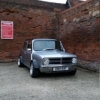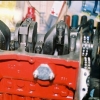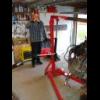I used DOT 5 in several high mileage cars, after a full brake system overhaul, replacing all seals, hoses (Goodridge, cheaper than OEM in some cases) and pipes (Kunifer of course, NEVER copper), and they went on to achieve very high mileages, up to 200k, without further attention to the brakes, except routine pad, and occasionally disc, changes. The fluid remained clean, and did not need to be changed.
However, none of these cars was a Mini, and although I have had 3 Minis and must have flushed and bled the brake systems many times, including full seal and hose replacements on 2 of them, and never had the slightest difficulty in bleeding any of them, there are many sad tales on this forum of people who can't get them to bleed (may depend on brake system configuration), and for that reason I would suggest that the use of DOT 5 in a Mini is strictly for experts, or those with a reliable method, such as a suction bleeder, of getting the air out. The rubber hose in jar technique never works properly, and certainly will not with DOT 5.
If you are worried about brake temperature, and the risk of sudden failure caused by boiling fluid, upgrade to DOT 5.1, but note that it absorbs water faster than DOT 4, and should be changed more frequently. DOT 4 should always be changed every 2 years or less, and it is very clear from this forum that there are a great many Minis on the road where that is never done, and are seriously risking brake failure when it boils, as well as accelerated corrosion of cylinders. Numerous clutch problems are also caused by neglect of the hydraulics, so do it at the same time. It is cheaper, as well as being much safer, to rigorously adhere to the recommended fluid change interval, as you will get longer life from seals and cylinders. And, never, ever do anything that carries the slightest risk of getting traces of mineral oil in the system, such as using penetrating oil on hydraulic unions or bleed nipples, as it only needs a trace to destroy all the seals in the system.





















